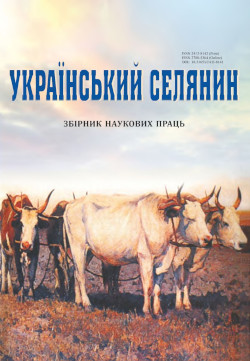“I creep with the cross, i cover with the cross”: the protection of the space of sleep in the mythological imaginations of Ukrainians
Main Article Content
Abstract
The purpose of the article is to study the parameters of the mythological space that do not fit into the matrix of materia mundi.
The scientific novelty lies in an attempt to consider magical means, with the help of which the construction of not only the obvious / “this”, but also the hidden / “that” space of the myth takes place. We are talking about a dream, which is considered in the context of a meaningful element of culture and forms local content modules focused on the interpretation, modeling and organization of the space of traditional society.
Conclusions. The principles of space organization, which relate to liminal states, have their own specificity. In particular, ritual actions were performed before going to sleep, which were supposed to protect the body temporarily left by the soul. In the mythology of Ukrainians, during sleep, the soul made a journey to the “other” world, which explained the origin of prophetic dreams. For this purpose, with the help of delineating the boundary and baptism formed in such a radius, the local space where the dreamer’s body was located was isolated. Such actions were accompanied by the recitation of magical texts
and prayers. The respective configurations are iconic, as they duplicate ornamental and iconographic subjects associated with solar symbolism. The sun sanctified by the sign of the cross, which protects the dreamer’s body, can also be interpreted as an ideogram of a prayer to the Life-giving Holy Cross and duplicates the imposition of the “Seal of God”, protecting the dreamer from the deadly dangers of the night. Protected in this way, the “soul” and “body” are considered to be impregnable to otherworldly forces that can harm and inhabit the dreamer (phenomenon of doppelgangers).
Article Details
References
Baiburin, A. (1983). Zhilishche v predstavleniyakh vostochnikh slavyan. [Dwelling in the Ideas of the Eastern Slavs]. Leningrad: Nauka. [in Russian].
Bednenko, G. Prostranstvo mifa. [Space of Myth] Retrieved from https://cyberleninka.ru/ article/n/prostranstvo-mifa (access date: 11.07.2023). [in Russian].
Berezovaya, N. Telo kak granitsa: «ozhivayushchie mertvetsi» «v sagakh ob islandtsakh» [The Body as a Border: “the Resurrecting Dead” “in the Sagas about the Icelanders”]. Retrieved from http://www.ruthenia.ru/folklore/berezovaya1.htm (access date: 26.07.2019). [in Russian].
Danforth, Christopher M. (April 2013). Chaos in an Atmosphere Hanging on a Wall. Retrieved from http://www.mpe2013.org/2013/03/17/chaos-in-an-atmosphere-hanging-on-a-wall/ (access date: 18.07.2023). [in English].
Dittrich, A. (1998). Standardized Psychometric Assessment of Altered States of Consciousness (ASCs) in Humans. Pharmacopsychiatry, 31, 2, 7, 80-84. [in English].
Eliade, M. (1987). Kosmos i istoriya. Moskva: Progress. [Space and History]. Moscow: Progress. [in Russian].
Fasmer, M. (1987). Etimologicheskii slovar russkogo yazika [Etymological Dictionary of the Russian Language]. Larina. Moskva : Progress, 3 (Muza–Syat). [in Russian].
Fedorov, Yu. Narysy z medychnoi teolohii. [Essays on Medical Theology]. Retrieved from https://medinstytut.lviv.ua/wp-content/uploads/%D0%9D%D0%90%D0%A0%D0%98%D0%A1%D0%98_%D0%97_%D0%9C%D0%95%D0%94%D0%98%D0%A7%D0%9D%D0%9E%D0%87_%D0%A2%D0%95%D0%9E%D0%9B%D0%9E%D0%93%D0%86%D0%87.pdf (access date: 18.07.2023). [in Ukrainian].
Fulkanelli, Zh-Zh. (2008). Taini goticheskikh soborov. [Secrets of Gothic Cathedrals]. Moskva: Refl -buk, Vakler. [in Russian].
Hobson, A. (2009). The neurobiology of consciousness: Lucid dreaming wakes up. International Journal of Dream Research, 2(2), 41–44. URL : https://psycnet.apa.org/record/2011-14175-001(access date: 18.07.2023). [in English].
Kyryliuk, O. (2000). Universal Parameters of Socio-Cultural Spatiality: Ukrainian Hut. [Universalni parametry sotsiokulturnoi spatsialnosti: ukrainska khata]. Universalni vymiry ukrainskoi kultury. [Universal Dimensions of Ukrainian Culture]. Retrieved from https://www.myslenedrevo.com.ua/uk/Sci/Culturology/uvuk/Dwelling.html (data zvernennia: 11.07.2023). [in Ukrainian].
Ludwig, A. (1966). Altered states of consciousness. Archives of general psychiatry, 15, 225-234. [in English].
Materiali dlya Slovarya drevnerusskogo yazika po pismennim pamyatnikam. Trud I. I. Sreznevskogo. [Materials for the Dictionary of the Old Russian Language According to Written Monuments. I.I. Sreznevsky’s Work] (1903), Izdanie otdeleniya russkogo yazika i slovesnosti Imperatorskoi akademii nauk. [Edition of the Department of the Russian Language and Literature of the Imperial Academy of Sciences]. Sankt-Peterburg : Tipografi ya Imperatorskoi akademii nauk, 3. [in Russian].
Polesskie zagovori (v zapisyakh 1970-1990-kh godov) [Polesye Conspiracies (in the Records of the 1970-1990s)] (2003), (Ed) Agapkina, T. A., Moskva : Indrik. [in Russian].
Saienko, V. (2004). «Lyst do turetskoho sultana» ta deiaki mifolohichni vidpovidnosti. [“A Letter to the Turkish Sultan” and Some Mythological Correspondences]. Novi doslidzhennia pamiatok kozatskoi doby v Ukraini. [New Studies of Mmonuments of the Cossack Era in Ukraine], 13, 418-420. [in Ukrainian].
Sorochuk, L. (2011). Mythological Space in the Ethnic Culture of Ukrainians. [Mifolohichnyi prostir v etnokulturi ukraintsiv]. Ukrainoznavchyi almanakh. [Ukrainian Studies Almanac], 5, 175-178. URL: http://nbuv.gov.ua/UJRN/Ukralm_2011_5_59 (access date: 11.07.2023). [in Ukrainian].
Temchenko, A. (2011-2012). Tsentr i peryferiia: dynamika tvorennia obriadovoho prostoru. [Center and Periphery: the Dynamics of Creation of Ceremonial Space]. Eidos [Eidos], 6, 260-268. [in Ukrainian].
Temchenko, A. (2017). Mifolohiia prostoru: semantyka horyzontali v tradytsiinykh uiavlenniakh skhidnykh slovian (na materiali zamovlian). [Mythology of Space: the Semantics of the Horizontal in the Traditional Ideas of the Eastern Slavs (a Study of Orders)]. Visnyk Cherkas koho universytetu. Seriia «Istorychni nauky». [Bulletin of Cherkasy University. Series “Historical Sciences”],4, 42-50. [in Ukrainian].
Temchenko, A. (2022) Smyslova para «somnia — mortem» v mifolohichnii kartyni svitu slovian. [The semantic pair “somnia — mortem” in the mythological picture of the world of the Slavs]. Narodoznavchi zoshyty. [Ethnological notebooks], 4 (166), 850-867. [in Ukrainian].
Tykhovska, O. (2016). Psykholohichne pidhruntia obrazu dvodushnyka v ukrainskii mifolohii. [The Psychological Basis of the Image of the Duplicitous in Ukrainian Mythology]. Naukovyi visnyk Uzhhorodskoho universytetu, Seriia: Filolohiia. [Scientifi c Bulletin of Uzhhorod University, Series: Philology], 2 (36), 242-248. [in Ukrainian].
Tytar, O. (2008). The Logic of the Myth in the Space of Modern Culture [Lohika mifu v prostori suchasnoi kultury] Bulletin of the Kharkiv National University named after V. N. Karazin [Visnyk Kharkivskoho natsionalnoho universytetu im. V. N. Karazina], 813. Retrieved from http:// dspace.univer.kharkov.ua/handle/123456789/6349 (access date: 07.11.2023). [in Ukrainian].
Voevodina L. Mif kak simvolicheskaya sistema. [Myth as a Symbolic System]. Retrieved from https://cyberleninka.ru/article/n/mif-kak-simvolicheskaya-sistema (access date: 11.07.2023). [in Russian].
Yakuts, R. (2010). Mifolohichnyi chas-prostir u povisti M. Hoholia «Vii». [Mythological Time-Space in M. Gogol’s Story “Vii”]. Sotsiokulturni problemy liudyny. [Sociocultural Problems of a Man], 4, 107-114. [in Ukrainian].

